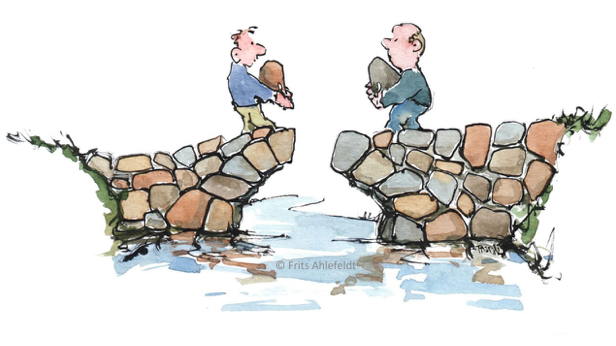The Problem with Solutions & How to Fix It

This is the seventh and final post in a series about framing climate and ocean change.
When environmental advocates talk about problems, they sometimes leave out one of the most important parts of the discussion: solutions.
This error of omission has significant consequences. When the public isn’t reminded of solutions to social problems or don’t understand how they work, they can become fatalistic and hopeless—and unmotivated to take action or demand change. This is especially true when it comes to climate and ocean change—one of the most complex issues of our time. To effectively frame this issue, environmental advocates must fill out their frame—communicating what’s at stake, how the problem works, and importantly, what can be done to change the situation.
So far, the posts in this series have covered the beginning and middle of this story: the values that help people understand why climate and ocean change matter and the metaphors and examples that help them understand how it works. This series also covered what to leave out of the story—the values that backfire and the traps in public thinking that can trip up environmental messages. These recommendations are grounded in extensive communications research conducted over two decades by the FrameWorks Institute, a think tank in Washington, DC. In 2015, FrameWorks released a report in conjunction with the National Network for Ocean and Climate Change Interpretation (NNOCCI) that summarizes the findings.
This series ends as well-framed climate communications do: with a discussion of solutions. Solutions are the frame element that help people understand the civic actions they might take to address a social problem. Solutions might be promising initiatives, effective programs, or recommended decisions. Incorporating solutions into communications helps the public understand that there are existing, feasible, and systems-level approaches that they can take to make things better and encourages them to take steps to enact those solutions.

Many environmental communications include solutions that encourage individual, household-level actions. We’ve all heard—and perhaps repeated—familiar behavior change slogans. They tell us to “give a hoot—don’t pollute” and to “reduce, reuse, and recycle.” They urge us to “use it up, wear it out, make it do, or do without” and to “live simply—so others may simply live.” We may assume these slogans are effective ways to communicate about the solutions we need to protect our planet. After all, they encourage people to “go green,” and they’re short, sweet, and sticky.
But are they enough? The short answer is no. Here’s why: To truly address climate and ocean change, action at the collective level is essential—not just the aggregation of individual behaviors, but fundamental policy shifts that can, for example, spur wide-scale movement toward clean energy. This is not to say that individual actions aren’t important. They are—and messaging that encourages them has led to important changes. But individual actions simply will never be enough to solve our most pressing environmental challenges.
What’s more, highlighting individual solutions may even backfire because it draws attention away from the societal solutions we need people to think about and demand.
Americans are fed a steady diet of “news you can use” messages about how to live greener lifestyles. But they need a more balanced diet of information; they need to consume more messages about systemic and structural solutions so they can practice thinking about them. You might say they need the communications equivalent of more lean proteins and leafy greens in their diet of environmental messages.
So, what do these kinds of messages look like?
Instead of urging people to turn out the lights, they might encourage people to support a proposal that would subsidize solar power and show how it reduces our reliance on fossil fuels. Instead of asking people to get out of their cars and onto their bikes, they might talk about how a public bike-sharing initiative is reducing rampant carbon dioxide, and tell the story of community involvement that led to its adoption. Instead of urging people to eat less meat, they might ask them to contribute to the “Meatless Monday” movement and explain how our society’s growing carbon “foodprint” affects our air, land, and water.
Environmental communications are a precious resource. Advocates must make sure they use this resource wisely. If they do, they will move Americans away from their tendency to focus on individual consumption choices and toward collective solutions. And they will encourage people to think of government intervention as an appropriate way to address our problems, which aligns with expert views.
A final word of advice: Of all frame elements, solutions are most likely to be interpreted as partisan or political—which can shut down discussion. When crafting solutions messages, avoid partisan cues, which can activate confirmation bias—our tendency to incorporate information that confirms our social group’s beliefs and to reject ideas we perceive as coming from another “tribe.” To avoid triggering this cognitive reflex, use words like elected official instead of politician, proposal instead of legislation, and statewide agreement instead of government mandate. And be sure to take an even-toned, explanatory approach.
In sum, we have a problem with the way we talk about solutions. But we can solve it with complete, explanatory, and systems-based story.
For more information about how to advance and enhance environmental communications, read How to Talk about Climate Change and the Ocean; download these “reframe cards” for a summary of tested frame elements; watch a short video of reframes in action. Click here for more resources about effective environmental communications frames, and read our latest article on solutions frames.
More Blog Posts
 Newly Released: The Drawdown ReviewNewly Released: The Drawdown Review by Elizabeth Bagley, May 22 2020 Reprinted with permission from The Drawdown Review by Project Drawdown © 2020 Project Drawdown. All rights reserved. In the spring of 2017, Project Drawdown released its inaugural body of work on climate solutions with the publication of the best-selling book Drawdown and [READ MORE]
Newly Released: The Drawdown ReviewNewly Released: The Drawdown Review by Elizabeth Bagley, May 22 2020 Reprinted with permission from The Drawdown Review by Project Drawdown © 2020 Project Drawdown. All rights reserved. In the spring of 2017, Project Drawdown released its inaugural body of work on climate solutions with the publication of the best-selling book Drawdown and [READ MORE] National Network for Ocean and Climate Change Interpretation (NNOCCI) Impacts After 5 YearsNational Network for Ocean and Climate Change Interpretation (NNOCCI) Impacts After 5 Years by Sarah-Mae Nelson, MS, CIG/CIT, February 13 2016 Since 2009, the National Network for Ocean and Climate Change Interpretation—better known as NNOCCI—has been a collaborative effort to raise the discourse around climate change and ocean acidification. Led [READ MORE]
National Network for Ocean and Climate Change Interpretation (NNOCCI) Impacts After 5 YearsNational Network for Ocean and Climate Change Interpretation (NNOCCI) Impacts After 5 Years by Sarah-Mae Nelson, MS, CIG/CIT, February 13 2016 Since 2009, the National Network for Ocean and Climate Change Interpretation—better known as NNOCCI—has been a collaborative effort to raise the discourse around climate change and ocean acidification. Led [READ MORE] Of Penguins & Solar PanelsOf Penguins & Solar Panels by Billy Spitzer, August 28 2018 Here’s a surprising penguin fact: much like our own communities, African Penguins and the ecosystems they’re part of benefit from our transition away from fossil fuels and toward renewable energy. Like many people, we at the New England Aquarium believe in safeguarding people and [READ MORE]
Of Penguins & Solar PanelsOf Penguins & Solar Panels by Billy Spitzer, August 28 2018 Here’s a surprising penguin fact: much like our own communities, African Penguins and the ecosystems they’re part of benefit from our transition away from fossil fuels and toward renewable energy. Like many people, we at the New England Aquarium believe in safeguarding people and [READ MORE] The Science of ExtremesThe Science of Extremes by Richelle Tanner, July 13 2021 Extreme is a word that can send a climate communicator directly into the swamp: the word extreme is inherently a bit alarming, and vague enough to warrant a multi-sentence qualification when you use it. Even scientists disagree on what this word means and in which context it is appropriate. [READ MORE]
The Science of ExtremesThe Science of Extremes by Richelle Tanner, July 13 2021 Extreme is a word that can send a climate communicator directly into the swamp: the word extreme is inherently a bit alarming, and vague enough to warrant a multi-sentence qualification when you use it. Even scientists disagree on what this word means and in which context it is appropriate. [READ MORE] Metaphors Can Counter Misinformation about Climate ChangeMetaphors Can Counter Misinformation about Climate Change December 02 2016 This is the fifth post in a series about framing ocean and climate change. Our ability to communicate the science of climate change to the public is as important as ever. The outcome of the recent presidential and congressional elections and the state of public discourse [READ MORE]
Metaphors Can Counter Misinformation about Climate ChangeMetaphors Can Counter Misinformation about Climate Change December 02 2016 This is the fifth post in a series about framing ocean and climate change. Our ability to communicate the science of climate change to the public is as important as ever. The outcome of the recent presidential and congressional elections and the state of public discourse [READ MORE]